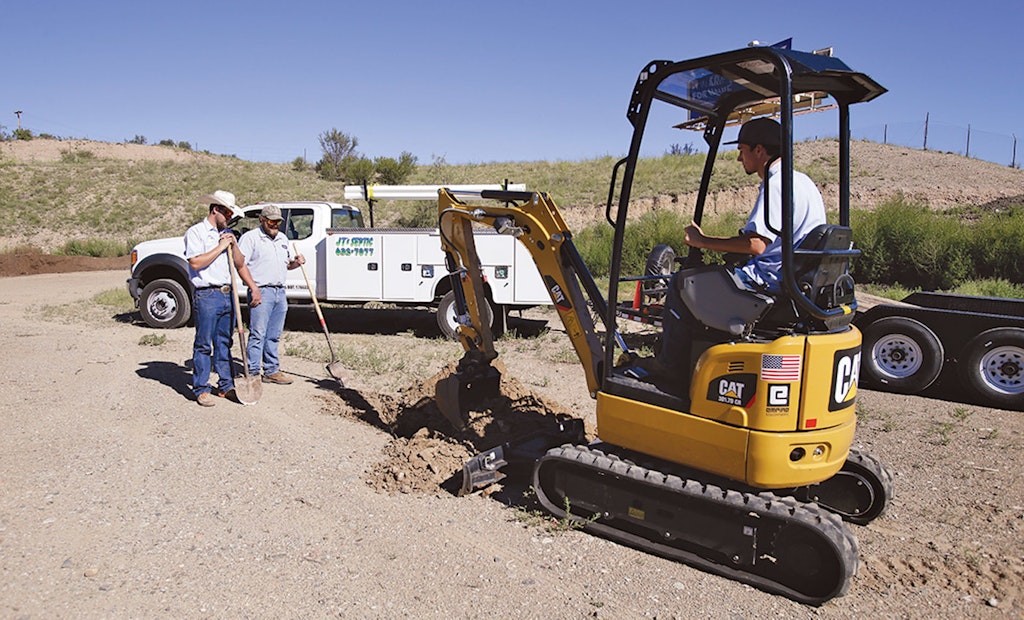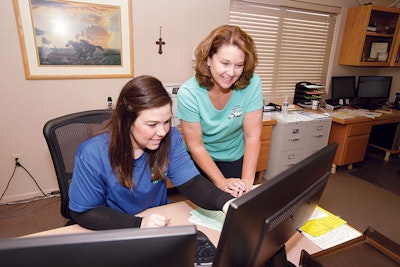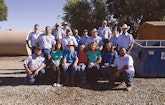
Interested in Onsite Systems?
Get Onsite Systems articles, news and videos right in your inbox! Sign up now.
Onsite Systems + Get AlertsFor JT’s Septic of Dewey-Humboldt, Arizona, the economic downturn a decade ago was a chance to reinvent the company and focus its energies on what it was best at: pumping, inspecting and repairing septic tanks.
The company was founded in 1994 by Jay Taulbee to install and repair septic tanks. Located 80 miles north of Phoenix, the business serves surrounding Yavapai County and adjacent areas. Jay’s wife Julie ran the office. Son’s Jesse and Zeb Taulbee joined full time in 1996.
The company added a vacuum truck in 1998 and expanded to portable restroom rentals and service in 1999, eventually fielding 200 units. In 2000, JT’s Septic even began to manufacture its own precast concrete septic tanks.
The Arizona housing boom slowly went bust, beginning in 2006. The company went into survival mode, reassessing its strengths to ride out the coming recession. JT’s Septic had already dropped its portable restroom business, which was operating in a saturated market.
“We sold our precast septic tank business and got out of the installation business,” says Jesse, who now manages the business with his wife, Brenda. “We kept only the pumping business, inspections, and light repairs, concentrating on our bread-and-butter business.”
POSITIVE CHANGES
JT’s Septic already owned two older vacuum trucks and purchased a new 2006 Kenworth with a 2,300-gallon steel tank and a Masport pump built out by Tank World.
Inspections became an important source of revenue in 2006 when the Arizona Department of Environmental Quality required inspections for any person transferring a property with a septic system. The inspection doesn’t pass or fail, but it provides full disclosure to buyer and seller. Foreclosures and repossessions ramped up in 2008 and saw homes — particularly in nearby Prescott — changing hands with regularity.
“We also got some contracts from the federal Department of Housing and Urban Development,” Jesse says. “Each of the tanks in those homes had to be pumped out and inspected. If the banks repossessed a property, they shut the utilities off. We had to outfit our trucks with generators to provide electricity for jackhammers and carry freshwater for the inlet and outlet water tests.”
Electric-powered jackhammers are sometimes necessary to break through high desert soil in the area to uncover the septic system.
Brenda joined the company in 2012 after learning the ropes from her mother-in-law before she retired. “I jumped in headfirst and learned all of the policies, procedures and forms that she developed from scratch,” Brenda says. That same year, Jesse and Brenda started managing the business as Jay gradually reduced his role to advisor.
INVEST FOR THE FUTURE
Today, the company employs 15 people — five office staff and 10 fieldworkers — based on a 5-acre site. Brenda’s daughter, Ashley, and her husband, Kyle, joined the business in 2016. Teen son Braden does odd jobs and keeps the trucks clean. Son Travis lives in the north part of the state but hasn’t jumped into the business yet.
The company fields three main vacuum service trucks, all Macks.
“I took a chance and ordered them with automatic transmissions,” Jesse says. “The automatics give you more stopping powers on the biggest grades without touching the brakes and better traction control on loose gravel. The jake brake in the engine and the retarder in the transmission work really well. We’ll never go back to stick shifts.”
The Macks are outfitted with steel tanks and Jurop/Chandler pumps: a 2014 GU713 with 3,400-gallon waste/250-gallon freshwater tank; a 2015 GU432 with 2,500-gallon waste/200-freshwater tank; and a 2017 GU713 with 3,500-gallon waste/250-gallon freshwater tank. All three are built out by Tank World.
“In two of our trucks, we have a hot dog-shaped stainless steel water tank suspended inside the waste tank. That helps balance the loads,” Jesse explains.
The Macks are assisted by a 1996 Peterbilt 379, pulling a 7,000-gallon aluminum waste tanker built by Karymore and outfitted with a Challenger pump from National Vacuum Equipment. The company’s backup rig is a 1989 Ford L8000 with a 2,300-gallon steel tank and Battioni pump.
The trucks can carry any of four RIDGID SeeSnake L100 cameras and locators. Inspections are also aided by a Sparvision 200 camera system with locator and cable machine from Spartan Tool.
The company’s additional service trucks include a 2001 Chevy flatbed, and a 2006 Ford Diesel Super Duty and 2017 Ford F-450. A recent addition is a 2017 Caterpillar 301.7D CR mini-excavator, used to uncover septic tanks and assist in repairs.
SAFETY FIRST
Residential septic pumping represents the majority of JT’s Septic work, although the company is working on a five-year contract to pump restrooms and pit toilets for the Bradshaw Ranger District of the Prescott National Forest. Customers are spread out across a large service area, so long drives are common. “On most of our contracts, we do more driving than pumping,” Brenda says.
Mountain cabins offer an extra challenge for pumping and inspections. “For some of the cabins, we might have to pull out 400 feet of suction hose to reach the tanks,” Jesse says.
The safety of septic systems is the company’s No. 1 priority. “If we see a system that has a broken lid, we’ll fix it whether we get paid or not,” Jesse says. “It’s not worth having someone fall into the tank.”
JT’s Septic dewaters all wastewater it collects under a separate division of the company operated by Zeb: a great alternative to the original drill of hauling the septage to Surprise, Arizona, 120 miles away. The wastewater is first screened to remove trash and then introduced to a dewatering system supplied by AQUA-Zyme Disposal Systems. SNF Polydyne CLARIFLOC polymer is used to separate solids from liquids. Solids are then hauled to a landfill, while liquids are dispersed into several large leach lines on the premises. The plant can process up to 3,000 gallons per day.
NAWT CERTIFIED
Inspections command an equal share of the company’s efforts with the remaining 10 percent devoted to septic system repair.
The field crew members are all cross-trained in pumping and repair and certified by the National Association of Wastewater Technicians to perform septic system inspections. A team of three typically handles septic system repairs, which include inlets and outlets, risers, clean-outs and baffles. Crews will also seal top seams against root intrusion and cut access portals in tanks.
A few years ago, Jesse initiated a company policy to switch out smaller 4-inch filters with 6-inch TUF-TITE filters during all outlet repairs. The pumping crew also recommends TUF-TITE risers, lids and filters to make maintenance easier in subsequent visits. “The 6-inch filters are really helping homeowners because they don’t have to service the filters as often,” Jesse says.
The company believes in education matched by experience. Even office staff assists with inspections and accompany fieldworkers on assignments. “Office staff is the relationship builder between our customers and field staff,” Brenda says. “We educate homeowners every day about their septic systems, but we can only do that well if we know what we’re talking about.”
CONSTANT LEARNING
That principle hit home at education sessions at the couple’s first trip to the Water & Wastewater Equipment, Treatment & Transport Show in 2015.
“Those classes opened our eyes,” Jesse says. “Today, we might, for example, talk customers through maintenance procedures that will keep the system running so they can save for a new system a few years down the line. We’ve also been developing our website to provide a good educational resource.”
Following their first WWETT Show, JT’s Septic developed a company uniform to show a more professional face to customers. The WWETT Show also confirmed some principles on which the company had been succeeding.
“We decided long ago that we would charge what we needed to charge to provide professional service, regardless of what we saw competitors charging,” Jesse says. “We need to charge enough to provide good trucks and hire good employees so that we can provide superior service.”
The education sessions have proved so helpful that the business has reserved spots for crew members at recent WWETT Shows.
The company’s best advertisement is its Mack trucks, which the Taulbees call their rolling billboards. JT’s Septic also promotes itself through Realtor associations and educational events.
Although customers still continue to ask whether they’ll install a tank or provide a precast unit as they did more than a decade ago, JT’s Septic is thriving on its core business. “We have friends who do installation, and we recommend their services,” Jesse says. “We’ve grown by concentrating on the services that the market demands.”
Finding industry friends
Jesse and Brenda Taulbee, husband-and-wife managers of JT’s Septic, have found that operating a septic service company can be lonely. “We were the only people we knew in the (industry), and sometimes it feels like you’re facing a lot of challenges alone,” Brenda says.
That changed at the 2015 Water & Wastewater Equipment, Treatment & Transport Show when the couple met Jason and Jaime Kubik, owners of Southwick Liquid Waste in Hickman, Nebraska.
“We kept seeing them in every class we attended,” Brenda says. “We have a lot of things in common: We’re the same age, and we operate companies of similar size. We bounced ideas off each other and shared marketing tools, disappointments and business highlights. It’s really helped us grow as a company.”
The Taulbees and Kubiks have only met once at the WWETT Show but keep in touch through regular emails.
The Taulbees also credit their forward-looking attitude to involvement with professional associations, such as the Arizona Onsite Wastewater Recycling Association and local agencies, including the Yavapai County Environmental Services Division. They value mentorship from Jake Garrett, wastewater manager in nearby Gila County.
“Meeting other people and organizations addressing the same issues increases your confidence,” Jesse says. “You know that you’re not the only one in the world facing a particular set of challenges. Even your competitors can offer great support.”










